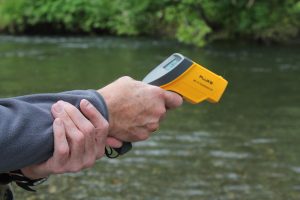
Thom Eley wears a bright orange vest and camo pants. He stands on the shore of Campbell Creek near Bancroft Park. It’s peaceful. The occasional airplane overhead is the only reminder that we’re in the middle of Alaska’s biggest city.
“This is sort of our neighborhood beach,” Eley said. “And people come here, the kids play here.”
Some folks raft down the creek too, including Eley, who’s in charge of research and education for the Anchorage Waterways Council.
“I got bounced off the end of the raft and went into the water and got a big mouthful of water and I was like, ‘Oh my gosh, this may not be fun,’ but it caused no problems,” Eley said. “But, I mean there’s always the concern that it can.”
When it gets hot in Anchorage, many people cool off with a swim or a float down the city’s creeks and streams. But is that safe? DEC data show that for almost all of the city’s creeks and streams levels of fecal coliform bacteria are higher than the safety standards for drinking, swimming or even secondary activities like rafting and kayaking. The bacteria can lead to some unpleasant health problems, like urinary tract infections and diarrhea.
“We have it in our gut tract,” Eley said. “It’s an indicator species that says there is poop getting into this water of some sort or another.”
Poop: that’s the main problem with Anchorage’s waterways.
To be fair, it could be worse.
Most U.S. cities have to contend with big industries like agriculture or manufacturing that can leach chemicals or heavy metals into their streams. Anchorage’s creeks flow straight from the Chugach Mountains.
And fecal coliform doesn’t cause problems for fish, just humans.
Still, it’s enough of an issue that it worries Eley.
“I personally wouldn’t swim here,” Eley said.
The municipality is required to conduct a certain number of tests a year. And their data show lower levels of fecal coliform than DEC’s. But their monitoring is limited to storm water outfalls and not the creeks themselves.
The rest pretty much falls on Anchorage Waterways Council volunteers through a citizen monitoring program. Eley says the non-profit has struggled to find funding for basic materials.
“Mainly it’s on donations,” Eley said. “We’ve crept along, but it’s hard.”
Eley tests for temperature, oxygen levels and pH. Finally, he fills a white bucket to check for fecal coliform.
“And what we do is we take five milliliters of water and put it in here and mix it up. And then I take it back home and put it in a Petri dish, and then it incubates overnight at 98 degrees,” Eley said.

What’s causing the high levels is a bit of a mystery. Testing is expensive and sometimes imprecise. It’s identified horse poop in areas where there are no horses in Anchorage.
Most arrows point to dogs and water fowl like ducks and geese. But human waste may be playing a role too. In some streams, it could be leaky septic tanks on the hillside. And in others, homeless camps.
Eley points across the stream to a well-worn pathway down to the water.
“When you start having lots of homeless people living along creeks, you know, and they drink and they may want to bathe. Although I wouldn’t drink this water, but people do, I’ve seen it,” Eley said. “And um, so it can get into the water.”

Jeanne Swartz works for DEC’s division of water.
“People have asked me about homeless camps and their contribution,” Swartz said. “Like most people I suspect the lack of sanitation facilities for the homeless population has contributed to the bacteria load problem, but I don’t have any data to support that thought.”
Swartz said high levels of bacteria popped up when Anchorage started monitoring its waterways in the 80s. Campaigns to get people to pick up after their dogs and stop feeding birds have been successful in specific areas. But DEC’s data is only partial. It hasn’t studied the issue comprehensively since 2000, when it identified dog poop as the main culprit.
“We just have anecdotal evidence that it’s gotten better. That doesn’t mean that much,” Swartz said. “It’s not worthless. But you can’t quantify it and do model calculations and things like that.”
But, that’s about to change. She’s just received a decade’s worth of data from Eley and his team. By 2019, she hopes to have it analyzed for trends. They’ll use that to identify problem areas to focus on and to help understand whether waste from homeless camps and septic tanks is contributing to the problem.
So — should you go for a swim or not?
Swartz says yes, but taking a shower after swimming and avoiding putting your face in the water is advised.
Erin McKinstry is Alaska Public Media's 2018 summer intern. She has an M.A. from the University of Missouri's School of Journalism and a B.A. from Knox College. She's reported stories for The Trace, The Midwest Center for Investigative Reporting, Harvest Public Media, the IRE Radio Podcast, KBIA and The Columbia Missourian.




